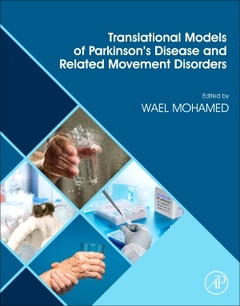Description
Translational Models of Parkinson’s Disease and related Movement Disorders
Coordinator: Mohamed Wael
Language: English
Subjects for Translational Models of Parkinson’s Disease and...:
480 p. · 21.4x27.7 cm · Paperback
Description
/li>Contents
/li>Biography
/li>Comment
/li>
Translational Models of Parkinson?s Disease and Related Movement Disorders focuses on cutting-edge techniques for creating and validating current Parkinson?s Disease translational experimental models. Various characteristics of these models are examined, including the prion-like properties of -synuclein, mitochondrial functions connected to the PINK1-Parkin pathway/CHCHD2, the endolysosome pathway connected to LRRK2, VPS35, and ATP13A2 using cultured cells (including patient iPS cells). This book also highlights the future possibilities of introducing new models for Parkinson?s Disease and related movements disorders, underscoring current advancements, pre-clinical and clinical developments, and future scope related to numerous models.
SECTION-I: PATHO-PHYSIOLOGY, DIAGNOSIS and PHARMACOTHERAPY OF PD AND RELATED MOVEMENT DISORDERS 1. Fundamentals of PD Pathophysiology 2. Neuroinflammation, Glymphatic system and PD 3. Pharmacotherapy of PD and Related Movements disorders and their limitations 4. Diagnosis and Biomarkers of PD and related movement disorders 5. PD Plus and Atypical PD 6. Parkinson’s Disease, Dementia with Lewy Bodies, and Multiple System Atrophy as a-Synucleinopathies 7. OMICS and Bioinformatics in PD and related movements Disorders 8. Modeling Parkinson’s Disease With the Alpha-Synuclein Protein SECTION-II: BIOCHEMICAL AND CELLULAR MODELS OF PARKINSON’S DISEASE OF PARKINSON’S DISEASE 9. a-Synuclein Seeding Assay and Analysis 10. LRRK2 in Tissues and Cultured Cells 11. Midbrain Dopaminergic Neurons and PINK1-Parkin using Human iPS Cells 12. Models SHH, Nurr1, Pitx3, and EN1 SECTION-III: MAMMALIAN MODELS OF PARKINSON’S DISEASE 13. 6-OHDA, MPTP, and Rotenone Rodent Model of PD 14. a-Synuclein Mouse Models of Parkinson’s Disease 15. Common Marmoset (Callithrix Jacchus) Model of a-Synuclein 16. Stem Cell for PD: Technical Considerations 17. Deep Brain Stimulation Using Animal Models of Parkinson’s Disease 18. Transgenic Animal Model of Parkinson's disease/dementia with Lewy bodies 19. The MitoPark Mouse Model 20. The BSSG rat model of Parkinson’s disease SECTION-IV: INVERTEBRATE MODELS OF PARKINSON’S DISEASE 21. LRRK2 in Caenorhabditis elegans Model 22. SCA1 Zebra Fish Model 23. MPTP model of PD 24. Drosophila PD Model 25. Neurotoxin-induced silkworm model for PD 26. Caenorhabditis elegans models of tauopathy 27. Various ZF models of PD: what is give us Hope? SECTION-V: ETHICAL AND REGULATIONS RELATED TO PD TRANSLATIONAL PD MODELS 28. Confounding Factors for validation of PD models 29. Neurobehavioral characterization of PD models 30. Imaging usea in PD models: pros and cones 31. Ethical regulations for induction and validation of PD models 32. OMICS and PD models: Hpes or Hypes
- Highlights induction and validation of different available experimental models of Parkinson’s Disease
- Provides a comparative prospect of different experimental models of Parkinson’s Disease
- Discusses the advantages and disadvantages of each model, including associated limitations




